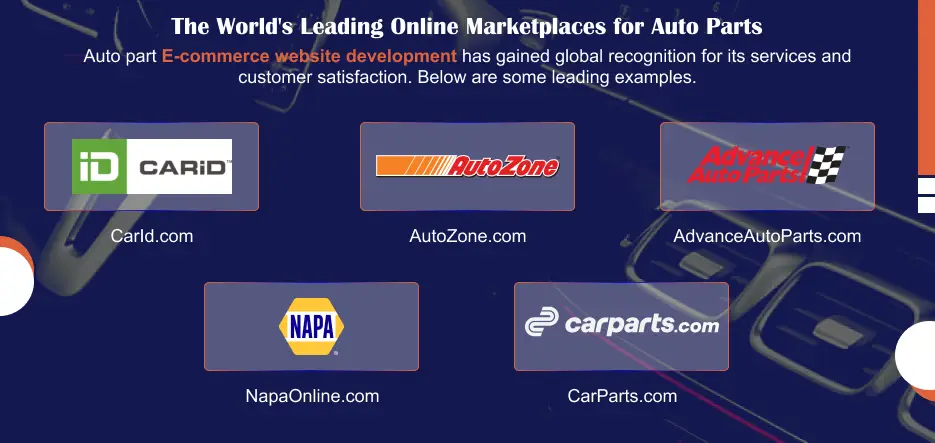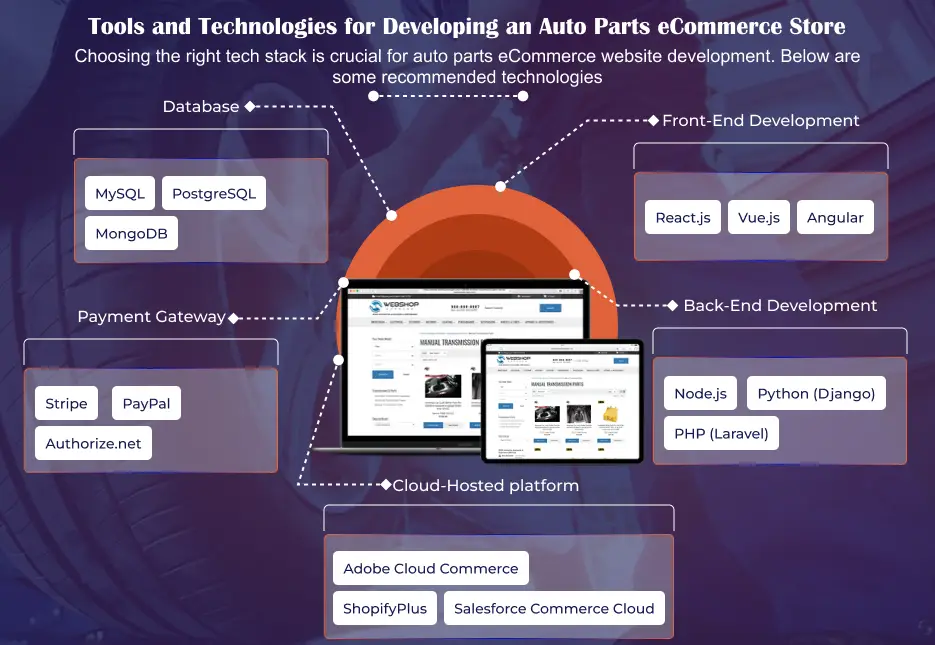Table of Contents
The automotive industry has seen a great revolution since eCommerce. Customers may get vehicle components more easily thanks to e-commerce platforms. For a hassle-free shopping experience, online store development connects the customer, manufacturer, and supplier. It helps the buyers select either authentic pieces or after-market pieces through a few clicks. Here, we will take you through every detail of auto parts e-commerce website development, which even includes cost estimates with required features.
Must know Key stats and facts about Auto Parts Industry –
- The global automotive industry is valued at more than $2 trillion.
- With a 16.6% CAGR expected to reach USD 343.13 billion by 2032 from USD 100.14 billion in 2024, the auto parts E-commerce industry is expected to increase.
What type of Auto Parts E-commerce Websites Do You Want to Develop?
Auto parts e-commerce website serves different business models depending on the target audience. These websites can be classified into three primary categories.
eCommerce Portals for B2C Auto Parts
B2C or Business-to-consumer websites focus on selling auto parts directly to end consumers. These platforms require an easy-to-use interface, high-quality product images, and detailed descriptions. A B2C auto parts online store allows customers to search for parts, compare options, and make purchases without intermediaries. Examples include websites like AutoZone and CarID, which provide comprehensive catalogs and fast delivery services.
eCommerce Websites for B2B Auto Parts
B2B eCommerce websites cater to wholesale buyers, garages, and distributors who purchase auto parts in bulk. These auto parts online e-commerce stores feature advanced functionality like tiered pricing, bulk ordering, and invoicing options. The primary users of B2B websites are businesses that need to restock their inventory regularly. These websites require robust backend systems to manage large orders and provide real-time inventory tracking.
Web Applications for Auto Parts Marketplace
Auto parts marketplace platforms serve as intermediaries between sellers and buyers. Similar to Amazon or eBay, these platforms allow multiple vendors to list their products while offering customers the convenience of browsing various brands in one location. These websites must incorporate sophisticated search algorithms and payment gateways to handle transactions between different parties. Auto parts marketplace platforms provide an opportunity for small manufacturers to reach a larger audience.
What are the Types of Auto Parts Available for Sale
Choosing the right inventory is essential for the success of an auto parts eCommerce website. Various categories of auto parts can be sold, each with unique characteristics and profit margins.
Original Equipment Manufacturer Parts
OEM parts are produced by the same company that manufactures the vehicle. These parts meet the exact specifications of the original components, ensuring perfect fit and function. OEM parts generally carry higher price tags due to their guaranteed quality and compatibility. However, they are preferred by consumers who want reliable performance and durability.
Original Equipment Supplier Parts
OES parts come from third-party suppliers who produce components that meet OEM standards. These parts are often identical to OEM products but may be sold under a different brand name. They offer similar quality to OEM parts at slightly lower prices, making them a popular choice for consumers seeking cost-effective solutions without compromising on quality.
Aftermarket Auto Parts
Aftermarket parts are produced by manufacturers other than the original vehicle maker. These parts are designed to fit various models and brands, providing more versatility. Aftermarket components are usually less expensive than OEM parts, which makes them attractive to budget-conscious consumers. However, quality can vary depending on the manufacturer. Websites selling aftermarket parts must ensure clear product descriptions and compatibility checks.
Ready to Accelerate Your Auto Parts Business?
Partner with us for Expert eCommerce Website Development.
How do Auto Parts Websites Generate Revenue?
Successful auto parts eCommerce websites employ various revenue-generation strategies. Understanding these models can help optimize profitability.
1. Featured Listings
Websites can charge vendors for premium placement of their products on the homepage or category pages. Featured listings increase product visibility and drive higher sales. Offering different tiers of promotion allows sellers to choose how prominently they want their products displayed.
2. Advertisements
Selling ad space on the platform can generate additional revenue. Banner ads, sponsored content, and pop-ups can be offered to suppliers and related automotive businesses. Integrating targeted advertising ensures that users are shown relevant content based on their search behavior, increasing click-through rates.
3. Garage Partnerships
Partnering with garages and repair shops can create a win-win situation. Auto parts websites can offer discounted rates to garages, allowing them to buy parts in bulk. In return, garages can refer their customers to the website for replacements or upgrades. This integration can strengthen relationships and expand the customer base.
4. Collaboration
Collaborating with major auto brands can provide opportunities for exclusive deals and promotions. Highlighting specific brands can attract dedicated buyers who are loyal to those manufacturers. Offering incentives, such as discounts or bundled packages, can further encourage brand engagement.
The World’s Leading Online Marketplaces for Auto Parts
Auto part E-commerce website development has gained global recognition for its services and customer satisfaction. Below are some leading examples.

1. CarID.com
CarID provides a comprehensive selection of aftermarket parts, performance components, and accessories. The website is known for its user-friendly interface and detailed product descriptions, helping customers find the right parts quickly.
2. AutoZone.com
As one of the largest auto parts retailers in the United States, AutoZone offers a broad catalog that includes both OEM and aftermarket components. The platform provides tools like VIN lookup and part verification to ensure compatibility.
3. AdvanceAutoParts.com
Advance Auto Parts focuses on convenience and fast shipping, making it a go-to platform for DIY mechanics and professionals alike. The site also offers repair guides and how-to videos, enhancing customer engagement.
4. NapaOnline.com
NAPA Online emphasizes quality and reliability, providing premium automotive parts and accessories. The platform features an intuitive search function that allows users to quickly locate the exact parts they need based on vehicle specifications.
5. CarParts.com
CarParts.com is known for its affordability and comprehensive inventory. The website offers frequent promotions and discounts, attracting budget-conscious buyers while maintaining high product standards.
Building a Feature-rich Auto Parts eCommerce Website
A successful auto parts eCommerce website development service requires incorporating essential features that enhance user experience and streamline operations.
1. Social Login & Signup
Allowing users to log in via social media accounts simplifies the registration process. Social login can improve user engagement and reduce cart abandonment rates.
2. Refine Search & Filters
Advanced filtering options help users quickly locate the parts they need. Filters based on price, brand, vehicle type, and specifications can enhance the shopping experience.
3. Auto Parts Finder
An auto parts finder tool enables users to search for specific parts by entering vehicle details. The tool cross-references a database of compatible parts, ensuring accuracy and reducing returns.
4. Year/Make/Model Lookup
Providing a Year/Make/Model lookup feature allows customers to search for parts based on their vehicle’s specifications. This function ensures that users purchase the correct parts, preventing costly mistakes.
5. Verify Fitment
Fitment verification tools check the compatibility of parts with the user’s vehicle. Providing a clear fitment compatibility table enhances trust and reduces return rates.
6. AI-driven Recommendations
AI-powered recommendation systems suggest relevant products based on user behavior, previous purchases, and browsing history. Personalized recommendations increase average order value by promoting cross-sells and upsells.
7. Information-rich product pages
Product pages should provide detailed information about each component, including specifications, usage, and installation guides. High-quality images, customer reviews, and related products enhance the shopping experience.
8. Shipping Cost estimation
Accurate shipping cost calculation is crucial for transparent pricing. Integrating tools that offer real-time shipping rates based on the user’s location can prevent unexpected charges at checkout.
9. Domestic & International Integrated Payment Gateway
Supporting multiple payment methods, including international options, is essential for catering to a global audience. Secure payment gateways that support various currencies and methods, such as credit cards, PayPal, and Apple Pay, are necessary.
10. Upselling & Cross-Selling
Suggesting complementary products during the checkout process can increase the average cart value. For example, offering an oil filter with a bulk order of engine parts can encourage buyers to add more items to their cart.
11. Reports & Analytics
Advanced reporting tools allow admins to track sales performance, inventory levels, and customer behavior. Real-time analytics provide actionable insights that can optimize marketing strategies and product offerings.
12. Traffic Driving Blogs
Content marketing plays a significant role in driving traffic to eCommerce websites. A dedicated blog section can offer tips, tutorials, and product comparisons to engage customers and improve SEO rankings.
Auto Parts eCommerce Website Development – Advanced Features
Integrating advanced features can elevate the website’s functionality and user experience, providing a competitive edge.
1. AI ChatBot Integration
AI chatbots can provide real-time customer support, answering common queries and guiding users through the purchasing process. Chatbots reduce the need for human intervention and enhance customer satisfaction.
2. Real-Time Analytics
Real-time data analysis enables businesses to monitor traffic, conversion rates, and customer behavior. This information can be used to make data-driven decisions and optimize marketing campaigns.
3. Smart Search Integration
Smart search features, such as auto-complete and voice search, enhance the search functionality, making it easier for users to find parts. AI-based algorithms can learn user preferences and provide personalized search results.
4. Voice Support
Voice-enabled search tools allow users to find parts by simply speaking into their devices. This feature enhances the accessibility of the platform, particularly for mobile users.
5. AI Recommendations
Artificial intelligence development services can analyze user behavior to provide personalized product recommendations. These suggestions increase the likelihood of customers discovering relevant products they may not have initially considered.
Start Building Your Auto Parts eCommerce Website Today!
Integrating Multiple Channels for Online Auto Parts Website
Effective integration with external systems is essential for managing operations, inventory, and customer relationships.
1. ERP Integration
Integrating with ERP systems allows for automated inventory management, financial tracking, and order fulfillment. ERP systems help streamline backend operations and ensure real-time data accuracy.
2. CRM Integration
CRM systems help businesses track customer interactions, manage leads, and offer personalized marketing. Integration of CRM ensures better customer service and improved retention rates.
3. POS Integration
POS systems allow businesses to track in-store and online sales through a unified platform. This integration improves inventory management and provides a complete view of business performance.
4. RMA Reporting and Flow
Return Merchandise Authorization tools help manage the return and exchange process efficiently. RMA integration streamlines returns, providing better customer satisfaction and improving post-purchase service.
Auto Parts eCommerce Store – Features for Success
Successful auto parts eCommerce websites share several common characteristics that contribute to their success.
1. Quick Shipping
Customers expect quick delivery, especially for urgent repairs. Offering fast shipping options and clear delivery timelines is crucial for customer satisfaction.
2. Hassle-free Return Policy
A hassle-free return policy instills confidence in buyers. Clear guidelines for returns and exchanges can enhance customer trust and encourage repeat purchases.
3. Robust Security measures
Implementing robust security measures, including SSL certificates and two-factor authentication, protects user data and prevents breaches. Cybersecurity is paramount in maintaining trust and credibility.
4. Rapid Loading Speeds
Website performance, especially load speed, affects user experience and search engine rankings. Fast-loading pages reduce bounce rates and improve customer retention.
5. Responsive Design
A mobile-responsive design ensures that the website functions optimally on all devices, including smartphones and tablets. Given the growing trend of mobile shopping, this is a critical feature.
6. Product Image Rich website
High-quality product images, including multiple angles and close-ups, give customers a better understanding of the product they are purchasing. Detailed photographs reduce returns and increase customer confidence.
Approaches to Developing Auto Parts eCommerce Store
There are three major ways in which an e-commerce website for auto parts might be developed, each with clear merits and demerits.
Develop from Scratch
You can build your website from scratch. With this, you can do everything and make it however you want. Of course, this is a very time-consuming and resource-intensive effort. If you have special features or rather need some complex services, then custom development is the best recommendation. The minimum cost to develop a custom eCommerce website begins at about $50,000 and can be much higher as the complexity of the system increases.
Self-Hosted Store using Open-Source Platforms
When you use open-source platforms such as Magento or WooCommerce, it is much cheaper than custom website development. Open-source platforms usually come with ready-made functionality and templates so businesses can run their shop without a lot of hassle. The cost to develop a self-hosted eCommerce site runs in the range of $10,000 to $40,000, depending on how customized you want to make it and the requirements for hosting.
Cloud-Hosted eCommerce Platforms
Cloud-Hosted platforms, such as Shopify or BigCommerce, are the most user-friendly options to be able to come up with an e-commerce store. These handle hosting, security, and updates; hence, businesses can focus on selling. However, they offer far less customization in comparison to open-source or built-in-house websites. The cost of usage for hosted platforms usually covers a subscription for every month together with charges for transactions.
Developing an Online Website for Auto Parts: A Framework for the Team
Auto parts eCommerce website development requires a dedicated team with specialized skills. The ideal team structure includes:
1. Project Manager
The project manager oversees the e-commerce website development process, ensuring that deadlines and deliverables are met.
2. UI/UX Designer
A UI/UX designer creates intuitive interfaces and ensures a seamless user experience. Their role is critical in designing an engaging and user-friendly platform.
3. Front-End Developer
Front-end developers are responsible for implementing the design and creating interactive elements. They ensure that the website functions properly across all devices and browsers.
4. Back-End Developer
Back-end developers handle server-side programming, database management, and integrations with external systems like ERP and CRM. Their expertise ensures that the website operates smoothly and securely.
5. QA Specialist
A QA specialist tests the website for bugs, performance issues, and security vulnerabilities. They ensure that the website meets the highest standards before it goes live.
Tools and Technologies for Developing an Auto Parts eCommerce Store

Choosing the right tech stack is crucial for auto parts eCommerce website development. Below are some recommended technologies:
| Development Area | Recommended Technologies |
|---|---|
| Front-End Development | React.js, Vue.js, Angular |
| Back-End Development | Node.js, Python (Django), PHP (Laravel) |
| Database | MySQL, PostgreSQL, MongoDB |
| Cloud-Hosted platform | Adobe Cloud Commerce, Shopify Plus, Salesforce Commerce Cloud |
| Payment Gateway | Stripe, PayPal, Authorize.net |
How Much Does it Cost to Develop an Auto Parts eCommerce Store?
The cost to develop an auto parts eCommerce website varies significantly based on the chosen development approach, required features, and complexity.
| Development Stage | Cost Range | Description |
|---|---|---|
| Basic Website | $20,000 – $30,000 | Includes fundamental features like product listings, payment gateways, shipping calculators, etc. |
| Advanced-Feature Website | $50,000 – $100,000 | Includes AI-powered recommendations, CRM integration, real-time analytics, and more sophisticated features. |
| Ongoing Maintenance & Support | $5,000 – $10,000 (per year) | Covers updates, security patches, and technical support to keep the website operational and secure. |
Conclusion
Auto parts eCommerce website development is a rewarding endeavor that requires careful planning and execution. By understanding the types of websites, revenue models, and essential features, A3Logics, a custom e-commerce development service provider can create a platform that meets the needs of its target audience. Whether opting for a custom e-commerce solution or a hosted platform, the right approach depends on the business’s goals, budget, and technical requirements.
FAQs
Question- What is the best way to choose an appropriate auto parts e-commerce platform for selling car spare parts?
Answer- When choosing an online platform for selling auto spare parts, pay close attention to aspects like integration, security, scalability, customization, and technical support.
Question-What qualities are the most crucial for an online store selling auto parts to have?
Answer- Product descriptions, extensive search capabilities, safe payment methods, mobile friendliness, inventory and order management for sellers, and account provisioning for customers are all features of auto parts e-commerce sites.
Question- What steps can I take to keep my auto parts store’s online transactions safe?
Answer- Engage in conversation with clients, urging them to utilize SSL encryption and safe payment methods. You should also advocate frequent software upgrades, the use of two-factor authentication, and the teaching of good online conduct.







